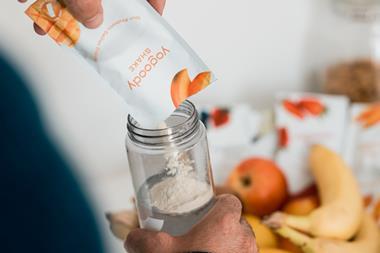Aggressive discounting in beer continues, but the trend is towards more 20-pack rather than 24-pack offers
After a year of aggressive discounting on beer, all eyes will be on the price tags in the beer aisles this Christmas to see just how low the sector can go.
And while many brewers are upbeat that prices this Christmas will not plummet further than last year, it still remains to be seen whether retailers will use extreme pricing tactics to increase footfall during the festive season.
“Last Christmas we saw some positive indicators, such as more 20-packs emerging from brewers rather than 24-packs,” says Kevin Brownsey, off-trade sales director at Coors Brewers. “Although we still saw prices we would prefer not to see, the consistency was a good sign.”
Indeed, discounting on beer at Christmas is something consumers have grown to expect over the past decade, with the average pence-per-litre price of standard lager at Christmas in the multiple grocers 6p less than in 1995, from £1.24 to £1.18 last year, according
to InBev UK’s MD of take-home, Stuart MacFarlane, who notes that premium lager has dropped 24p from £2.01 to £1.77 per litre over the same period.
He says: “If we put this into perspective, if beer prices had increased in line with inflation this would have added around £125m to the value of beer sales last Christmas. And if the average price of premium lager had simply been held at the same level as 1995 - £2.19 a litre - this would have increased the retail
value of Christmas beer sales in 2004 by £40m. There’s no doubt that we’ve lost ground as an industry since Christmas 1995 and, while we’re under no illusion that seasonal price-cutting is going to disappear overnight, there were positive signs of greater pricing stability last Christmas.”
Getting Christmas right is crucial for brewers, who recognise it as a period when many non-beer drinkers dip their toes in the category. Research by Diageo’s Guinness, for example, found 59% of four-pack shoppers of the brand only buy at Christmas.
Keith Hogg, group sales director at Scottish Courage Brewers, said this made it even more vital for big brands and retailers to get their prices and availability right. “People who don’t buy beer often aren’t likely to buy beer that is too cheap,” he says.
Hogg says activity from the big brands so far, in terms of pack sizes, is encouraging. “There is some sign we will be very competitive but I am hopeful, if there is a focus on big brands, that we may even see some price inflation this year. The use of different pack sizes by all the big brewers with their big brands is incredibly important to avoid price deflation in the market. There shouldn’t just be a focus on big packs, as lots of beer is sold in small packs at Christmas.”
Brownsey also says that consumers look for the top four or five brands at this time of year. “They also tend to buy in smaller quantities, so availability of beer in the £5-£8 bracket is essential.”
After a year of aggressive discounting on beer, all eyes will be on the price tags in the beer aisles this Christmas to see just how low the sector can go.
And while many brewers are upbeat that prices this Christmas will not plummet further than last year, it still remains to be seen whether retailers will use extreme pricing tactics to increase footfall during the festive season.
“Last Christmas we saw some positive indicators, such as more 20-packs emerging from brewers rather than 24-packs,” says Kevin Brownsey, off-trade sales director at Coors Brewers. “Although we still saw prices we would prefer not to see, the consistency was a good sign.”
Indeed, discounting on beer at Christmas is something consumers have grown to expect over the past decade, with the average pence-per-litre price of standard lager at Christmas in the multiple grocers 6p less than in 1995, from £1.24 to £1.18 last year, according
to InBev UK’s MD of take-home, Stuart MacFarlane, who notes that premium lager has dropped 24p from £2.01 to £1.77 per litre over the same period.
He says: “If we put this into perspective, if beer prices had increased in line with inflation this would have added around £125m to the value of beer sales last Christmas. And if the average price of premium lager had simply been held at the same level as 1995 - £2.19 a litre - this would have increased the retail
value of Christmas beer sales in 2004 by £40m. There’s no doubt that we’ve lost ground as an industry since Christmas 1995 and, while we’re under no illusion that seasonal price-cutting is going to disappear overnight, there were positive signs of greater pricing stability last Christmas.”
Getting Christmas right is crucial for brewers, who recognise it as a period when many non-beer drinkers dip their toes in the category. Research by Diageo’s Guinness, for example, found 59% of four-pack shoppers of the brand only buy at Christmas.
Keith Hogg, group sales director at Scottish Courage Brewers, said this made it even more vital for big brands and retailers to get their prices and availability right. “People who don’t buy beer often aren’t likely to buy beer that is too cheap,” he says.
Hogg says activity from the big brands so far, in terms of pack sizes, is encouraging. “There is some sign we will be very competitive but I am hopeful, if there is a focus on big brands, that we may even see some price inflation this year. The use of different pack sizes by all the big brewers with their big brands is incredibly important to avoid price deflation in the market. There shouldn’t just be a focus on big packs, as lots of beer is sold in small packs at Christmas.”
Brownsey also says that consumers look for the top four or five brands at this time of year. “They also tend to buy in smaller quantities, so availability of beer in the £5-£8 bracket is essential.”



















No comments yet